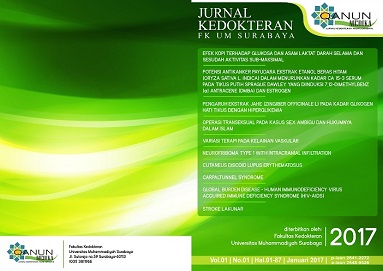Effects of Ginger Extract (Zingiber officinale L) on Glycogen Levels Liver on Mice with Hyperglycaemia
Abstract
Full text article
References
ADA. (2016) Standards of Medical Care in Diabetes – 2016. American Diabetes Association.39, pp.1–112. Available from :http://doi.org/10.2337/dc14-S014 [accessed 01 March 2012].
Abdulrazaq, NB., Cho, MM., Win, N.,Zaman, R. and Rahman, MT. (2012) Beneficial effects of ginger (Zingiber officinale) on carbohydrate metabolism in streptozotocin-induced diabetic rats. British J of Nutrition. 108(7) pp.1194-1201.
Adeniyi, PO and Sanusi, RA. (2014) Effect of ginger (Zingiber officinale) extracts on blood glucose in normal and steptozotocin-induced diabetic rats. Int J of Clinical Nutrition. 2(2), pp.32-35.
Akhani, SP., Vishwakarma, SL. and Goyal, RK. (2004) Anti-diabetic activity of Zingiber officinale in streptozotocin-induced type I diabetic rats. J Pharm Pharmacol.. 56, pp.101–105.
Al-Amin, ZM., Thomson, M., Al Qattan, KK., Peltonen-Shalaby, R. and Ali, M. (2006) Anti diabetic and hypoglycemic properties of ginger (Zingiber officinale) in streptozotocin-induced diabetic rats. British J of Nutrition. 96, pp.660-666.
Asha, B., Krishnamurthy, KH. and Devaru, S. (2011). Evaluation of anti hyperglycaemic activity of Zingiber officinale (Ginger) in albino rats. J Chem Pharm Res. 3, pp.452–456.
Badreldin, HA., Gerald, B., Musbah, OT. et al. (2008) ‘Some phytochemical, pharmacolo-gical and toxicological pro-perties of ginger (Zingiber officinale L)’: a review of recent research. Food Chem Toxicol. 46, pp.409–420.
Cheng, D. (2012) Prevalence, Predisposition and Prevention of Type II Diabetes. Nutrition & Metabolism. 2, pp.29. [accessed 01 March 2012].
Jafri, S.A., Abass, S. and Qasim, M. (2011) Hypoglycemic effect of Ginger (Zingiber officinale) in alloxan-induced diabetic rats (Rattus norvagicus). Pakistan Veteri-nary J. 31(2), pp.160-162.
Meigs, JB. (2007) Association of Oxidative Stress, Insulin Resistance, and Diabetes Risk Phenotypes. Diabetes Care. 30(10).[accessed 01 March 2012]
Pessin, JE., Saltiel, AR. (2010) Signaling Pathways in Insulin Action: Molecular Targets of Insulin Resistance. J Clin Invest. 106(2) .[accessed 01 March 2012].
Shaw, JE., Sicree, RA., Zimmet, PZ. (2010) Global Estimates of The Prevalence of Diabetes for 2010 and 2030. Diabetes Research and Clinical Practice; 87, p.4-14. [accessed 01 March 2012].
Shulman, GI. (2012) Insulin Resistance. J Clin Invest. 106(2). [accessed 01 March 2012].
Son, MJ., Miura, Y. and Kazum, Y. (2014) Mechanism of anti diabetic effect of gingerol in cultured cultured cells and obese diabetic model mice Cytotechnology. Diabetes Research and Clinical Practice. 87, pp.15-20. [accessed 01 March 2012].
Sukalingam K., Ganesan K. and Gani SB. (2013) Hypoglycemic effect of 6-gingerol, an active principle of ginger in streptozotocin-induced diabetic rats. J Pharmaco and Toxico Studies. 1(2), pp.23-30.
Wu, C., Khan, SA., Peng, LJ. and Lange, AJ. (2006) Roles for fructose-2,6-bisphosphate in the control of fuel metabolism beyond its allosteric effects on glycolytic and gluconeogenic enzymes. Adv. Enzyme Regul. 46 (1) pp.72-78
Authors

Qanun Medika by FK UM Surabaya is liscence under Lisensi Creative Commons Atribusi 4.0 Internasional.

